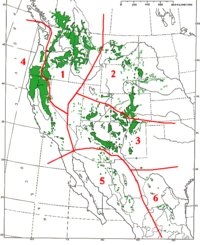Ponderosa Pine
|
|
| Ponderosa Pine Conservation status: Secure | ||||||||||||||||
|---|---|---|---|---|---|---|---|---|---|---|---|---|---|---|---|---|
 Ponderosa Pine branch bark, needles, trees | ||||||||||||||||
| Scientific classification | ||||||||||||||||
|
Ponderosa Pine (Pinus ponderosa) is a widespread and very variable pine native to western North America. See the table below for the botanical characters of the different types.
In most texts separated into two varieties, modern forestry research has shown that there are four different taxa in Ponderosa Pine, with differing botanical characters and adapted to very different climatic conditions. These have been termed "geographic races" in forestry literature, while some botanists have historically treated them as distinct species. In modern botanical usage, they best match the rank of subspecies, but not all of the relevant botancial combinations have been formally published yet. These are as follows:
Pinus ponderosa was first discovered by David Douglas in 1826 in eastern Washington near where Spokane now lies. This is within the area of the "North Plateau race", and this therefore is the type subspecies.
- 1 Pinus ponderosa subsp. ponderosa Douglas ex C. Lawson - "North Plateau Ponderosa Pine".
- Range & climate: southeast British Columbia, Washington and Oregon east of the Cascade Range, northeast California, northwestern Nevada, Idaho and western Montana. Cool, relatively moist summers; very cold, snowy winters.
- 2 Pinus ponderosa subsp. scopulorum (Engelm.) E. Murray - "Rocky Mountains Ponderosa Pine".
- Range & climate: eastern Montana, North Dakota, South Dakota, Wyoming, Nebraska, northern and central Colorado and Utah, and eastern Nevada. Warm, relatively dry summers; very cold, fairly dry winters.
- 3 Pinus brachyptera Engelm. - "Southwestern Ponderosa Pine"
- Range & climate: southern Colorado, southern Utah, northern and central New Mexico and Arizona, and westernmost Texas. Hot, relatively moist summers; mild winters.
- 4 Pinus benthamiana Hartw. - "Pacific Ponderosa Pine"
- Range & climate: Washington and Oregon west of the Cascade Range, California except for the northeast, and just into westernmost Nevada. Hot, dry summers; mild wet winters.
The distributions of the subspecies, and that of the closely related Arizona Pine (Pinus arizonica) are shown on the map. The numbers on the map correspond to the taxon numbers above and in the table below. The base map of the species range is from Critchfield & Little, Geographic Distribution of the Pines of the World, USDA Forest Service Miscellaneous Publication 991 (1966).
Before the distinctions between the "North Plateau race" and the "Pacific race" were fully documented, most botanists assumed that Ponderosa Pines in both areas were the same. So when two botanists from California found a distinct tree in western Nevada in 1948 with some marked differences from the Ponderosa Pine they were familiar with in California, they described it as a new species, Washoe Pine, Pinus washoensis. However, subsequent research has shown that this is merely a southern outlier of the typical "North Plateau race" of Ponderosa Pine.
Table of characters distinguishing the subspecies of Pinus ponderosa and Pinus arizonica
| Taxon | 1 North Plateau | 2 Rocky Mts | 3 Southwest | 4 Pacific | 5 Arizona | 6 Storm's | |
|---|---|---|---|---|---|---|---|
| Character | (ponderosa) | (scopulorum) | (brachyptera) | (benthamiana) | (arizonica) | (stormiae) | |
| Needles per fascicle | 3 | 2-3 | 2-3 | 3 | 4-5 | 3-5 | |
| Needle length | 10-22 cm | 8-17 cm | 12-21 cm | 15-30 cm | 12-22 cm | 20-30 cm | |
| Needle thickness | 1.7-2.2 mm | 1.5-1.7 mm | 1.6-1.9 mm | 1.3-1.7 mm | 1.0-1.1 mm | 1.0-1.2 mm | |
| Cone length | 5-11 cm | 5-9 cm | 5-10 cm | 7-16 cm | 5-9 cm | 6-11 cm | |
| Cone scale width | 14-19 mm | 16-20 mm | 14-19 mm | 18-23 mm | 15-18 mm | 12-17 mm | |
| Immature cone colour | purple | green | green | green | green | green | |
| Mature cone surface | matt | matt | glossy | glossy | glossy | matt | |
| Seedwing to seed length ratio | 1.9-2.5 | 2.1-3.4 | 3.0-3.5 | 3.0-4.7 | 2.8-3.2 | 3.0-3.5 | |
| Max tree height | 50 m | 40 m | 50 m | 70 m | 35 m | 20 m | |
| USDA hardiness zone | 4 | 4 | 6 | 7 | 7 | 8 |
Notes:
Taxon numbers refer to the map
Needles per fascicle - the most frequent number is in bold
Seedwing : seed length ratio - high numbers indicate a small seed with a long wing; low numbers a large seed with a short seedwingpl:sosna żółta

